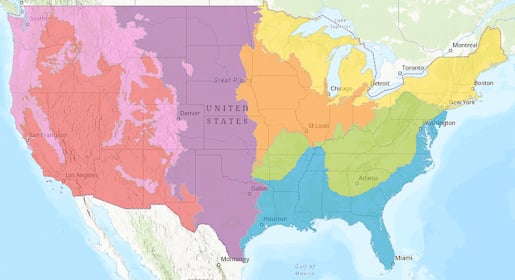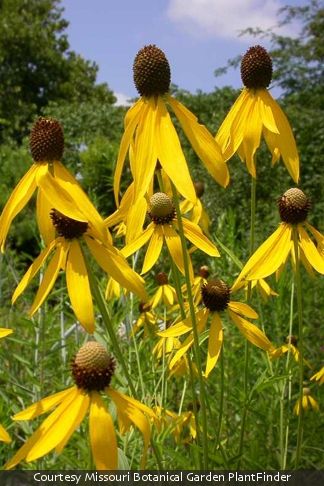Ratibida pinnata pinnate prairie coneflower
Characteristics
Descriptions
Light Requirements
Soil Moisture
Soil Description
Height
Recommended Spacing
Bloom Time
Bloom Color
Hardiness Zone
Description
Ratibida pinnata is a striking wildflower with robust, sparingly leaved branching stems that can grow to a height of 5'. The large terminal flowers are stunning, with bright yellow, drooping rays that are up to 3" long, and a conspicuous disk that starts out slightly domed and gray, becoming dark brown and cone-like as the seeds ripen. The leaves are pinnate (feather-like) and divided, hence the specific epithet pinnata (nothing to do with a Mexican piñata). Although the flowers are not fragrant, their disk will exude an anise-like aroma if rubbed or crushed. Great for use in naturalized settings, among other tall wildflowers and grasses. It enjoys a long blooming period that can last up to 2 months, between early to late summer.
Cultivation
Ratibida pinnata is easy to grow in average, well-drained soil, in full to part-sun. It is low maintenance, and mature plants can be considered drought resistant. It can be used in cottage gardens, planted in tight groups to compensate for the sparse appearance of the individual stems. They can have a tendency to flop over if grown in overly rich, moist soil, and might require additional support or staking under those conditions.
Recommended Spacing
Space plants 16"-24" on center.
Pinnate prairie coneflower is long-lived and has a robust, rhizomatous root system that will form tight clumps over time. Via rhizome and reseeding, it can spread to form colonies. That tends to happen in the more disturbed areas of sites where conditions are favorable. Planting with other tall competitors will keep it in balance (and provide some support if the tall stems lean).
Companion Plants
Combines beautifully with other tall perennials such as Echinacea pallida (pale purple coneflower, Veronicastrum virginicum (Culver's root), Coreopsis tripteris (tall tickseed), Eryngium yuccifolium (button eryngo), Vernonia fasciculata (prairie ironweed), and Liatris pycnostachya (prairie blazing star). Add in Ruellia humilis (wild petunia) and Symphyotrichum laeve (smooth blue aster) for blooms at a lower height. Round out the planting with grasses like Schizachyrium scoparium (little bluestem), Sorghastrum nutans (yellow prairie grass, Indiangrass), and Bouteloua curtipendula (sideoats grama).
Additional Notes
Pinnate prairie coneflower is very attractive to pollinators, especially bees. Other insects that you'll see available themselves of it include wasps, flies, small butterflies, and beetles. It also supports several species of caterpillars, including those of the Silvery Checkerspot, Wavy-Lined Emerald, and Common Eupithecia. Goldfinches eat the seeds. It is an excellent candidate for cut flowers. Native Americans used the flowers and cones to make tea, and the roots to soothe toothaches.

Pricing & Availability
Note: Early spring shipments might include plants that have not yet broken dormancy, or have not been vernalized and will be frost-tender. Please use your best judgment when selecting your preferred ship week.
Why choose plants from the nearest grower? Choosing a the grower closest to you makes it more likely the plants are consistent with your ecoregion and better adapted to your location. In addition, shipping plants shorter distances typically uses fewer resources, something we can all get behind!
BUY MORE, SAVE MORE
$50 off orders of $750 or more
$100 off orders of $1,000 or more
15% off orders of $3,000 or more
Maps, Wetland Status & More
MAP OF NATIVE RANGE
Recorded County Distribution: USDA data.
Native To
| AL, AR, CT, GA, IA, IL, IN, KS, KY, MA, MI, MN, MO, MS, NE, NJ, NY, OH, OK, PA, SC, SD, VA, VT, WI, WV, FL, LA |
Legal Status
| Extirpated | PA |
Wetland Status
MAP OF WETLAND DELINEATION REGIONS

Interpreting Wetland Status
|
Code |
Status |
Designation |
Comment |
|
OBL |
Obligate Wetland |
Hydrophyte |
Almost always occur in wetlands |
|
FACW |
Facultative Wetland |
Hydrophyte |
Usually occur in wetlands, but may occur in non-wetlands |
|
FAC |
Facultative |
Hydrophyte |
Occur in wetlands and non-wetlands |
|
FACU |
Facultative Upland |
Nonhydrophyte |
Usually occur in non-wetlands, but may occur in wetlands |
|
UPL |
Obligate Upland |
Nonhydrophyte |
Almost never occur in wetlands |
Classification
| Kingdom | Plantae | Plants |
| Subkingdom | Tracheobionta | Vascular plants |
| Superdivision | Spermatophyta | Seed plants |
| Division | Magnoliophyta | Flowering plants |
| Class | Magnoliopsida | Dicotyledons |
| Subclass | Asteridae | |
| Order | Asterales | |
| Family | Asteraceae | Aster family |
| Genus | Ratibida | prairie coneflower |
| Species | Ratibida pinnata | pinnate prairie coneflower |
ADDITIONAL COMMON NAMES:
prairie coneflower, gray-head prairie coneflower, drooping coneflower, grayhead coneflower, yellow coneflower, grayhead Mexican hat
SCIENTIFIC SYNONYMS:
Lepachys pinnata
Rudbeckia pinnata
Plant Sizes
Sizes info
Shipping & Planting
SHIPPING INFO:
Shipping is free on all plants orders!
Your plants will ship using each grower’s preferred method: FedEx Ground, UPS Ground, or Spee-Dee Ground (in select midwestern states). Our growers ship orders Monday through Wednesday. The farther your plants need to travel, the earlier in the week they will ship. The goal is to have all plants delivered by the end of the week.
Shipping plugs:
Plugs are shipped in full flats, sometimes also referred to as trays. Multiple flats can be shipped in a single box. The flats are wrapped in netting or craft paper to secure the plants, and spacers are used between flats to keep the plants from being crushed.
When you unpack your plugs, the plants will have been somewhat flattened by the netting or craft paper. They will straighten out within a couple of days. You may also gently “fluff” them a bit to speed up the process. In some cases, your plants might have been cut back before packing, if the grower deemed them to have become too tall for safe packaging. Don’t worry, though, these guys know what they’re doing and would not compromise the health of the plants. They’ll fill back in in no time.
After receiving your plants’ journey in a dark box, it will be important to acclimate them to sunlight again. Over a couple of days, you should gradually move them into their preferred light exposure, and water them as per their requirement.
Although we always recommend putting your plants in the ground as soon as possible, they can stay healthy in the flats for a considerable amount of time. The key is to respect their growing requirements: if the species requires full sun, do not store them in the shade. If it is best adapted to dry soil, do not over-water.
PLANTING INFO:
Planting plugs:
We consider plugs ready to ship when the plants’ roots have filled the entire liner cell and the plants can easily be pulled out. In some cases you will have to go about it gently, wiggling the plant by the crown, and possibly squeezing the bottom of the liner to compress the growing medium and release the roots. Other times, the plants will appear to be root bound. They are not in the traditional sense. The plants are healthy but they have used up all the growing medium available to them. Plugs are at an aggressive stage of growth. As soon as planted the roots will immediately expand into your native soil. They establish faster than plants in larger containers, because they don’t have the luxury of a lot of growing media that can inhibit the roots from venturing outside of their comfort zone.
We are not going to address area preparation because the process can be complex and is always site-specific. However, as a rule, we recommend disturbing the soil as little as possible, and we do not recommend amending the soil. If you chose the right plant for the right conditions they will thrive. Any disturbance and amendments will only encourage weeds to emerge that never had a chance to do so before.
Installing plugs cannot be easier: dig a hole large enough for the roots to fit snugly inside, then water them in to eliminate air gaps. We recommend using a soil knife, sometimes referred to as hori hori, or a drill-adapted auger if it’s a large installation. If you use an auger, you will need a powerful drill. Depending on the size of the project and the type of soil, the process can be beyond what an average drill will bear. Mulching is recommended after installation to help keep weeds down while the plants establish. Be sure to keep it away from the crown of the plants. For large projects, you may want to mulch the area before planting, rather than tiptoeing through it after the fact. As a side note: if you are installing plugs in the fall, you might want to plant them so that the crown is about ¾” lower than the surrounding soil. The winter’s freeze/thaw cycles can push plugs out if the roots did not have enough time to establish and anchor them in.





